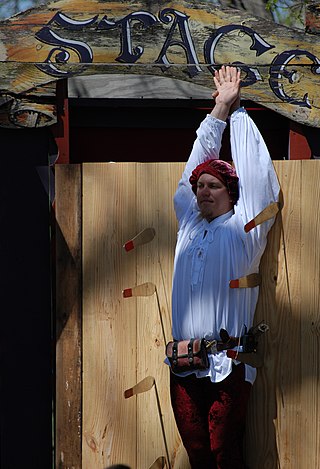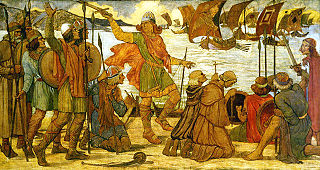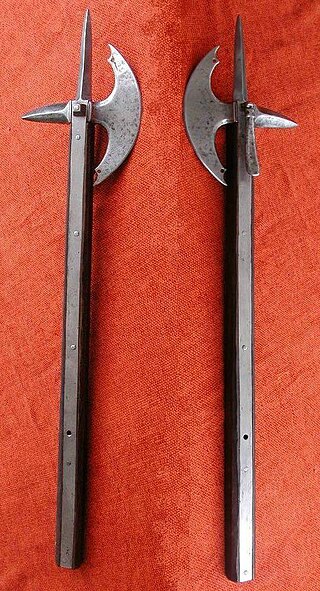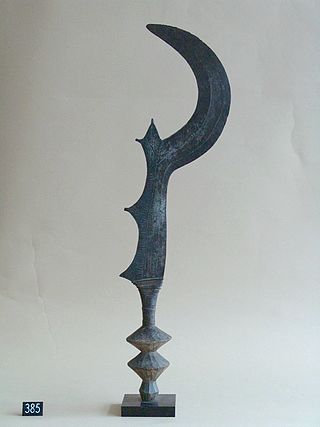
The Nzappa zap (also referred to as zappozap, nsapo, kilonda, kasuyu) is a traditional weapon from the Congo similar to an axe or hatchet.

The Nzappa zap (also referred to as zappozap, nsapo, kilonda, kasuyu) is a traditional weapon from the Congo similar to an axe or hatchet.
It has an ornate wrought-iron blade connected to a club-like wooden handle, often clad in copper, bronze or brass. [1] [2] [3]
Largely ceremonial, it can be used much like the American tomahawk, both thrown for short distances and as a melee weapon in hand-to-hand combat. It differs from the usual axe style, in that the blade mounts to looping prongs that affix to the shaft.
This weapon derives from the upper Congo region and was used as a brutal weapon in battle. It was usually crafted by the Nsapo people who thrived industrially from iron and copper. The axe is forged from Iron while the handle is made of wood covered in copper. This weapon yields a lot of damage when used mainly in close combat and sometimes directly thrown. [4] The Nzappa Zap has a club like handle that flares at the base and has a rounded head. The blade is also attached through a post extending from the handle. Nzappa Zaps sometimes has two or three human faces in the iron head. The axe is ceremonial and usually kept and carried by the chiefs of the Songye. The weapon holds power and significance among the people. [5] The axe was used in battle, as a status symbol, and also as a form of currency in trade. [6]
The weapon is the etymological base of the name "Zappo Zap", an infamous Songye tribal group once active in the Congo Free State.

A knife is a tool or weapon with a cutting edge or blade, usually attached to a handle or hilt. One of the earliest tools used by humanity, knives appeared at least 2.5 million years ago, as evidenced by the Oldowan tools. Originally made of wood, bone, and stone, over the centuries, in step with improvements in both metallurgy and manufacturing, knife blades have been made from copper, bronze, iron, steel, ceramic, and titanium. Most modern knives have either fixed or folding blades; blade patterns and styles vary by maker and country of origin.

A polearm or pole weapon is a close combat weapon in which the main fighting part of the weapon is fitted to the end of a long shaft, typically of wood, extending the user's effective range and striking power. Polearms are predominantly melee weapons, with a subclass of spear-like designs fit for thrusting and/or throwing. Because many polearms were adapted from agricultural implements or other fairly abundant tools, and contained relatively little metal, they were cheap to make and readily available. When belligerents in warfare had a poorer class who could not pay for dedicated military weapons, they would often appropriate tools as cheap weapons. The cost of training was comparatively low, since these conscripted farmers had spent most of their lives using these "weapons" in the fields. This made polearms the favoured weapon of peasant levies and peasant rebellions the world over.

A mace is a blunt weapon, a type of club or virge that uses a heavy head on the end of a handle to deliver powerful strikes. A mace typically consists of a strong, heavy, wooden or metal shaft, often reinforced with metal, featuring a head made of stone, bone, copper, bronze, iron, or steel.

The kukri or khukuri is a type of short sword with a distinct recurve in its blade that originated in the Indian subcontinent. It serves multiple purposes as a melee weapon and also as a regular cutting tool throughout most of South Asia. The kukri, khukri, and kukkri spellings are of Indian English origin, with the original Nepalese English spelling being khukuri.

A blade is the portion of a tool, weapon, or machine with an edge that is designed to puncture, chop, slice or scrape surfaces or materials. Blades are typically made from materials that are harder than those they are to be used on. Historically, humans have made blades from flaking stones such as flint or obsidian, and from various metal such as copper, bronze, and iron. Modern blades are often made of steel or ceramic. Blades are one of humanity's oldest tools, and continue to be used for combat, food preparation, and other purposes.

A tomahawk is a type of single-handed axe used by the many Indigenous peoples and nations of North America. It traditionally resembles a hatchet with a straight shaft. In pre-colonial times the head was made of stone, bone, or antler, and European settlers later introduced heads of iron and steel. The term came into the English language in the 17th century as an adaptation of the Powhatan word.

The kris or keris is a Javanese asymmetrical dagger with a distinctive blade-patterning achieved through alternating laminations of iron and nickelous iron (pamor). The kris is famous for its distinctive wavy blade, although many have straight blades as well, and is one of the weapons commonly used in the pencak silat martial art native to Indonesia. Kris have been produced in many regions of Indonesia for centuries, but nowhere—although the island of Bali comes close—is the kris so embedded in a mutually-connected whole of ritual prescriptions and acts, ceremonies, mythical backgrounds and epic poetry as in Central Java. Within Indonesia the kris is commonly associated with Javanese culture, although other ethnicities in it and surrounding regions are familiar with the weapon as part of their cultures, such as the Balinese, Sundanese, Malay, Madurese, Banjar, Buginese, and Makassar people. The kris itself is considered as a cultural symbol of Indonesia and also neighbouring countries like Brunei, Malaysia, Philippines, Singapore, and Thailand.

Knife throwing is an art, sport, combat skill, or variously an entertainment technique, involving an artist skilled in the art of throwing knives, the weapons thrown, and a target. In some stage performances, the knife thrower ties an assistant to the target and throws to miss them.

Knowledge about military technology of the Viking Age is based on relatively sparse archaeological finds, pictorial representations, and to some extent on the accounts in the Norse sagas and laws recorded in the 12th–14th century.

A battle axe is an axe specifically designed for combat. Battle axes were specialized versions of utility axes. Many were suitable for use in one hand, while others were larger and were deployed two-handed.

A pickaxe, pick-axe, or pick is a generally T-shaped hand tool used for prying. Its head is typically metal, attached perpendicularly to a longer handle, traditionally made of wood, occasionally metal, and increasingly fiberglass.

The francisca was a throwing axe used as a weapon during the Early Middle Ages by the Franks, among whom it was a characteristic national weapon at the time of the Merovingians. It is known to have been used during the reign of Charlemagne (768–814). Although generally associated with the Franks, it was also used by other Germanic peoples of the period, including the Anglo-Saxons; several examples have been found in England.
The traditions of Korean bladesmithing and swordsmanship have served a central place in the military history of Korea for thousands of years. Although typical Korean land battles have taken place in wide valleys and narrow mountain passes, which favor use of spears and bows, the sword found use as a secondary, close-quarters weapon, in addition to far more prominent role during sieges and ship-to-ship boarding actions. Higher quality, ceremonial swords were typically reserved for the officer corps as a symbol of authority with which to command the troops. Ceremonial swords are still granted to military officials by the civilian authority to this day.

A mambele is a form of hybrid knife/axe in central and southern Africa, originating from a curved throwing dagger used by the Mangbetu.

An axe is an implement that has been used for millennia to shape, split, and cut wood, to harvest timber, as a weapon, and as a ceremonial or heraldic symbol. The axe has many forms and specialised uses but generally consists of an axe head with a handle, also called a haft or a helve.

Listed here are the weapons of pencak silat. The most common are the machete, staff, kris, sickle, spear, and kerambit. Because Southeast Asian society was traditionally based around agriculture, many of these weapons were originally farming tools.

A throwing axe is a weapon used from Antiquity to the Middle Ages by foot soldiers and occasionally by mounted soldiers. Usually, they are thrown in an overhand motion in a manner that causes the axe to rotate as it travels through the air.

Native American weaponry was used by Native American warriors to hunt and to do battle with other Native American tribes and European colonizers.

A Ngulu is an execution sword used by the Bantu peoples of the Congo Basin.